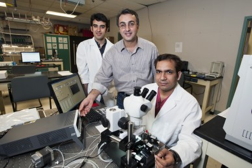Home > Press > Engineers fine-tune the sensitivity of nano-chemical sensor: Tweaking graphene chemical sensors may open up many applications
 |
Abstract:
Researchers have discovered a technique for controlling the sensitivity of graphene chemical sensors.
The sensors, made of an insulating base coated with a graphene sheet--a single-atom-thick layer of carbon--are already so sensitive that they can detect an individual molecule of gas. But manipulating the chemical properties of the insulating layer, without altering the graphene layer, may yet improve their ability to detect the most minute concentrations of various gases.
Engineers fine-tune the sensitivity of nano-chemical sensor: Tweaking graphene chemical sensors may open up many applications
Chicago, IL | Posted on May 8th, 2013The finding "will open up entirely new possibilities for modulation and control of the chemical sensitivity of these sensors, without compromising the intrinsic electrical and structural properties of graphene," says Amin Salehi-Khojin, assistant professor of mechanical and industrial engineering at the University of Illinois at Chicago, and principal investigator on the study. He and his coworkers at the UIC College of Engineering collaborated with researchers from the Beckman Institute and the Micro and Nanotechnology Laboratory at the University of Illinois at Urbana-Champaign and two institutions in Korea. Their findings are reported in the journal Nano Letter, available online in advance of publication.
Since its discovery nearly 10 years ago, graphene--in sheets, or rolled into nanotubes--has attracted huge scientific interest. Composed of a single layer of carbon atoms, graphene has potential for use in hundreds of high-tech applications. Its 2-D structure, exposing its entire volume, makes it attractive as a highly sensitive gas detector.
Salehi-Khojin's team, and others, earlier found that graphene chemical sensors depended on a structural flaw around a carbon atom for their sensitivity. They set out to show that "pristine" graphene sensors--made of graphene that was perfectly flawless—wouldn't work. But when they tested these sensors, they found they were still sensitive to trace gas molecules.
"This was a very surprising result," Salehi-Khojin said.
The researchers tested the sensor layer by layer. They found that pristine graphene is insensitive, as they had predicted.
They next set about removing any flaws, or reactive sites called dangling bonds, from the insulating layer. When a pristine insulating layer was tested with pristine graphene, again there was no sensitivity.
"But when dangling bonds were added back onto the insulating layer, we observed a response," said Bijandra Kumar, a post-doctoral research associate at UIC and first author of the Nano Letter study.
"We could now say that graphene itself is insensitive unless it has defects--internal defects on the graphene surface, or external defects on the substrate surface," said UIC graduate student Poya Yasaei.
The finding opens up a new "design space," Salehi-Khojin said. Controlling external defects in the supporting substrates will allow graphene chemFETs to be engineered that may be useful in a wide variety of applications.
K. Min, A. Barati Farimani, D. Estrada, E. Pop, and N.R. Aluru of the University of Illinois at Urbana-Champaign; M.-H. Bae of UIUC and the Korea Research Institute of Standards and Science; and Y.D. Kim and Y.D. Park of Seoul National University also contributed to the study.
The study was funded by UIC.
####
About University of Illinois at Chicago
UIC ranks among the nation's leading research universities and is Chicago's largest university with 27,500 students, 12,000 faculty and staff, 15 colleges and the state's major public medical center. A hallmark of the campus is the Great Cities Commitment, through which UIC faculty, students and staff engage with community, corporate, foundation and government partners in hundreds of programs to improve the quality of life in metropolitan areas around the world.
For more information, please click here
Contacts:
Jeanne Galatzer-Levy
312-996-1583
Copyright © University of Illinois at Chicago
If you have a comment, please Contact us.Issuers of news releases, not 7th Wave, Inc. or Nanotechnology Now, are solely responsible for the accuracy of the content.
| Related News Press |
News and information
![]() Simulating magnetization in a Heisenberg quantum spin chain April 5th, 2024
Simulating magnetization in a Heisenberg quantum spin chain April 5th, 2024
![]() NRL charters Navy’s quantum inertial navigation path to reduce drift April 5th, 2024
NRL charters Navy’s quantum inertial navigation path to reduce drift April 5th, 2024
![]() Discovery points path to flash-like memory for storing qubits: Rice find could hasten development of nonvolatile quantum memory April 5th, 2024
Discovery points path to flash-like memory for storing qubits: Rice find could hasten development of nonvolatile quantum memory April 5th, 2024
Graphene/ Graphite
![]() NRL discovers two-dimensional waveguides February 16th, 2024
NRL discovers two-dimensional waveguides February 16th, 2024
Sensors
Discoveries
![]() Chemical reactions can scramble quantum information as well as black holes April 5th, 2024
Chemical reactions can scramble quantum information as well as black holes April 5th, 2024
![]() New micromaterial releases nanoparticles that selectively destroy cancer cells April 5th, 2024
New micromaterial releases nanoparticles that selectively destroy cancer cells April 5th, 2024
![]() Utilizing palladium for addressing contact issues of buried oxide thin film transistors April 5th, 2024
Utilizing palladium for addressing contact issues of buried oxide thin film transistors April 5th, 2024
Announcements
![]() NRL charters Navy’s quantum inertial navigation path to reduce drift April 5th, 2024
NRL charters Navy’s quantum inertial navigation path to reduce drift April 5th, 2024
![]() Discovery points path to flash-like memory for storing qubits: Rice find could hasten development of nonvolatile quantum memory April 5th, 2024
Discovery points path to flash-like memory for storing qubits: Rice find could hasten development of nonvolatile quantum memory April 5th, 2024
|
|
||
|
|
||
| The latest news from around the world, FREE | ||
|
|
||
|
|
||
| Premium Products | ||
|
|
||
|
Only the news you want to read!
Learn More |
||
|
|
||
|
Full-service, expert consulting
Learn More |
||
|
|
||








